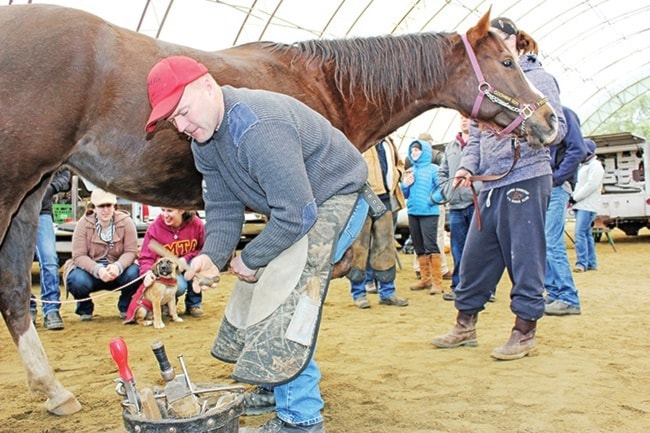Sparks were flying, smoke billowed and the iron glowed red hot as two of Canada's top farriers were in Errington March 1 for a unique clinic on equine hoof care.
Aimed at building bridges between horse owners, veterinarians and farriers in B.C., the clinic saw many horse owners in the community bring their animals and learn how to correctly shoe their beloved equines.
The stars at the gathering, besides the horses, were Bruce Hague and Iain Ritchie.
Members of the Western Canadian Farriers Association (WCFA) both have been on the Canadian Farrier Team and taken top honours at various international competitions.
The pair, along with Nanaimo Veterinarian Dr. Colin Scruton, volunteered their time and expertise to educate horse owners about equine foot health.
What was special about the free event held at the Tiger Lily Farm Equestrian Center was the gathering under one roof of so many professionals and owners who brought their horses.
Dr. Scruton brought his state of the art x-ray machine that could instantly take pictures of each horse being worked on and display the images from the computer onto a giant screen for all to see.
Shane Sampson, spokesperson for the WCFA, says not all veterinarians have the modern technology and by bringing it to the clinic it provided a complete picture of the health of the horse.
"This way they can see that we are not just chopping some foot off the bottom of the horse. The work has to be done correctly ... there's lots to it. With the x-ray machine we are actually shoeing to what is inside the foot not just the outside."
He said having an equine surgeon as well as farriers who are the best in the world is one of the ways the WCFA has been trying to strike a cord and get everybody involved.
"This is one of the only events of this type in all of B.C. right now where we get horse owners and the experts together in one room," he explained.
Sampson said veterinarians and farriers have common goals and by collaborating and sharing experiences with each other the main winner is the horse, but he said the clinic is also rewarding for horse owners, especially those who are not showing and don't get out much.
"Iain and Bruce are both upper level guys and Colin has spoken at other venues. We are pretty lucky to have them here. Horse owners can ask their questions and with a bunch of professionals they should get their question answered."
By organizing clinics and workshops, Sampson said the WCFA is striving to improve the standards within the farrier industry.
The March 1 event attracted about 75 horse owners and Sampson said it is an example of how all clinics should be done.
Farriery or horseshoeing is a very old profession that takes years of sweat and perseverance to master.
Farriers have to be knowledgeable in the sciences of equine anatomy, physiology and biomechanics, and also be skilled with a hammer and tongs to create custom shoes for each of their clients.
A skilled farrier can keep a horse's feet strong, healthy and in good form, but Sampson, who comes from a long line of farriers, agreed the centuries-old trade struggles with keeping people in the profession.
"There are not a lot of us. It is a physical demanding form of employment. Some people who get into the profession don't stay. They go to an accredited shoeing school and within a five year period afterwards over 95 per cent drop out of the field."
Competitive farriery is like the Olympics of blacksmithing and contests are held to advance the quality of workmanship within the industry and provide a platform for competitors to be judged amongst the best of their peers worldwide. Sampson agreed the clinicians gathered in Errington were some of the best in the world and he said he hopes the clinics gain more popularity so events can be held in other communities on Vancouver Island.
